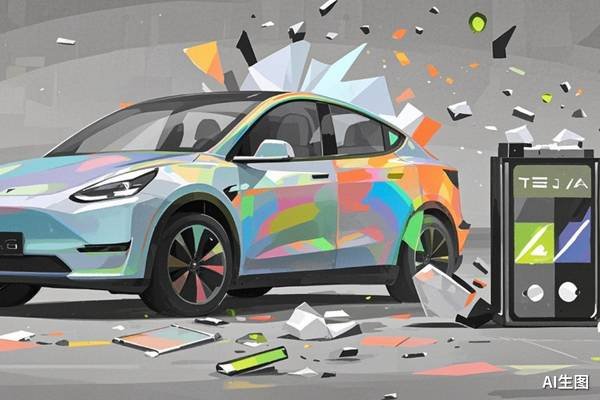The newly launched stripped-down Model Y from Tesla is facing controversy over its price.
On October 7th, to cope with the expiration of the US tax credit policy, Tesla simultaneously launched the standard versions of Model Y and Model 3 in North America. The starting prices of the two models are $39,990 (approximately RMB 289,000) and $36,990 (approximately RMB 268,000) respectively, which are about $5,000 (approximately RMB 35,000) and $5,500 (approximately RMB 39,000) cheaper than the previous versions.
However, this price cut did not bring the expected enthusiastic response. The reason is that this “discount” is actually based on obvious configuration reductions. Especially for the standard version of Model Y, from the exterior to the cockpit and then to the assisted driving functions, almost all the configuration adjustments point to one goal: to compress costs as much as possible.
Among the many changes, three have sparked the greatest controversy. First, the standard version of Model Y removed the through-type light strip between the two headlights and adjusted the shape of the front bumper, making its appearance significantly different from other versions. Some consumers said that this would make others easily recognize that they bought the “roughcast version,” giving them a feeling of being treated differently. Second, the automatic steering function in Autopilot was cancelled, which is already a standard feature in many economy electric vehicles. Finally, instead of directly replacing the metal roof, Tesla added a lining and sound insulation materials under the original panoramic sunroof. This means that if users want to keep the original panoramic sunroof, they have to pay extra to remove the newly added components.
Although the price was reduced by $5,000, it was not enough to offset the impact of the expiration of the tax policy. According to media calculations, consumers who choose the new standard version actually spend nearly $5,000 more than those who bought the old version before the policy expired.
Dan Ives, an analyst at Wedbush Securities, said: “I’m disappointed that these cars are only about $5,000 cheaper than the next-level models.” Many overseas netizens also expressed their dissatisfaction on the Reddit community. “Compared with other models, this car has lost so many functions. It’s definitely not worth it,” and “Even with a price of $35,000, it doesn’t have much competitiveness among similar products.” The capital market also responded: On the day of the new car launch, Tesla’s US stocks closed down 4.45%, and its market value evaporated by about $65 billion (approximately RMB 463 billion).
Tesla has always been an expert in price wars. Since 2023, Tesla has significantly cut prices multiple times globally, even triggering a continuous price cut wave in the Chinese auto market that is still ongoing. From 2017 to 2022, the average selling price of Tesla’s electric vehicles almost halved. Tesla, which is well aware of users’ price sensitivity, is now showing “lack of sincerity” in its approach, indicating that its cost compression has reached a bottleneck.
The financial report shows that Tesla’s net profit in the second quarter of this year decreased by 16% to $1.172 billion, and its gross profit margin dropped from 18% in the same period last year to 17.2%. In the first quarter, Tesla’s net profit plummeted by 71%.
Successive price cut policies have continuously squeezed the profit margin, and Tesla has already used the common cost – reduction methods in the market to the extreme. These include but are not limited to: researching and developing a centralized vehicle electronic and electrical architecture to reduce vehicle development costs; abandoning ultrasonic radars and using a pure vision solution to save hardware costs; using integrated die – casting technology to save manufacturing costs; integrating the supply chain and not investing in advertising to save promotion expenses… As a result, Tesla founder Elon Musk said bluntly at the third – quarter earnings conference last year: “Reducing costs by 20% is more difficult than designing a car and building a factory.”
In the cost – reduction arsenal, the highly – regarded 4680 battery has failed to deliver on its promise. The battery is the largest single cost item in new energy vehicles, usually accounting for 30% – 50% of the vehicle cost. Tesla released the 4680 battery as early as 2020, aiming to reduce costs by 50% through a new manufacturing process.
According to the original plan, the 4680 battery should have achieved mass production in 2021, with a global planned production capacity of 6 billion units. However, by 2024, the actual output was only 100 million units.
According to media reports last year, the research and development of the 4680 battery has always faced difficulties. Tesla lost 70% – 80% of the cathodes during trial production, while traditional battery manufacturers lose less than 2% of components due to manufacturing defects. The company has also been trying to expand the production of dry – coated 4680 batteries but has been unable to increase the battery production speed. This highly – anticipated project not only fails to support cost reduction in the short term but also continuously consumes R & D funds.
Relatively speaking, the cost of externally supplied batteries is still rising. Tesla warned in April this year that tariffs would have a huge impact on its energy business because it is dependent on Chinese lithium – iron – phosphate batteries. Tesla Chief Financial Officer Vaibhav Taneja said in the first – quarter earnings conference call that although the company plans to produce lithium – iron – phosphate batteries in the United States, the currently – being – debugged equipment can only meet a small part of the total installed capacity of its Megapack factory in Lathrop, California. To reduce its dependence on Chinese batteries, there were multiple reports this summer that Tesla agreed to purchase $4.3 billion worth of US – made batteries from South Korean battery manufacturer LG Energy to relieve the pressure on its energy storage business.
Although this reduces the tariff risk, it faces two problems. First, compared with Chinese batteries, the batteries from other suppliers are still not price – competitive. According to the analysis of research institution BloombergNEF, as of the end of 2024, the average price of Chinese battery packs was the lowest, at $94 per kilowatt – hour. The prices of battery packs in the United States and Europe were 31% and 48% higher respectively. On the other hand, using multiple suppliers will inevitably lead to a decrease in the order volume of a single supplier, thus affecting Tesla’s bargaining power.
The increase in battery cost is only part of the impact of tariffs on Tesla. The Trump administration imposed a 10% tariff on imported auto parts, increasing Tesla’s per – vehicle cost by about $1,200. The per – vehicle cost of Model S and Model X soared by more than $3,000. The mass – production plans of Cybercab and Semi were also hindered. Tesla originally planned to transport parts from China to the United States, but with the increase in tariffs, the plan had to be slowed down. Although part of the supply chain is gradually recovering, the losses caused by the disrupted rhythm and delays are still difficult to make up for.
The cost – reduction methods are running out, and the mountains of cost – increasing factors are still weighing on Tesla. At the second – quarter conference call, Tesla CFO Vaibhav Taneja said: “On a quarterly basis, the tariff cost increased by about $300 million, of which about two – thirds affected the automotive business, and a smaller part affected the energy business. However, considering the lag in invoicing and sales, the full impact will be reflected in subsequent quarters, so the cost will increase in the short term. Although we are trying our best to eliminate these impacts, we are in an unpredictable environment regarding tariffs.”
Tesla is earning less money but has more places to spend it. This is also the reason why Tesla has become “stingy” when cutting prices. Tesla’s revenue in the second quarter decreased by 12% year – on – year, but the financial report clearly stated: “While maintaining a strong and stable balance sheet, Tesla will continue to make high – value investments in capital expenditures and R & D.”
Elon Musk has publicly announced that he will shift his focus to autonomous vehicles and robot businesses, and the existing automotive business seems to have become a cash cow for these two new businesses. Some Wall Street analysts believe that the value of Tesla’s automotive business is less than $100 per share, only one – third of its approximately $300 share price.
Whether it is the extended – version Model Y L or the continuously stripped – down standard version of Model Y, they are just old wines in new bottles, and it is hard to see the sincerity in the model replacement. And the only new model Tesla has launched in the past five years is the Cybertruck, which has a controversial appearance and dismal sales.
When discussing the standard version of Model Y, some netizens also recalled the stripped – down Cybertruck. The starting price of the all – wheel – drive Cybertruck was $80,000, and after the configuration reduction, it was $10,000 cheaper. However, Tesla also cut key configurations such as a motor, active air suspension, electric truck bed cover, and power interface. This version had a low cost – performance ratio, and few people placed orders. Less than 5 months after its launch, Tesla discontinued it.
Now, Tesla is repeating a similar logic. Although it has been launched in North America, Tesla’s Chinese team has not publicly responded to whether and when this version will be introduced to the Chinese market.
This article is from the WeChat public account “Power Plant”, author: Zhai Fangxue, published by 36Kr with authorization.


Leave a Reply